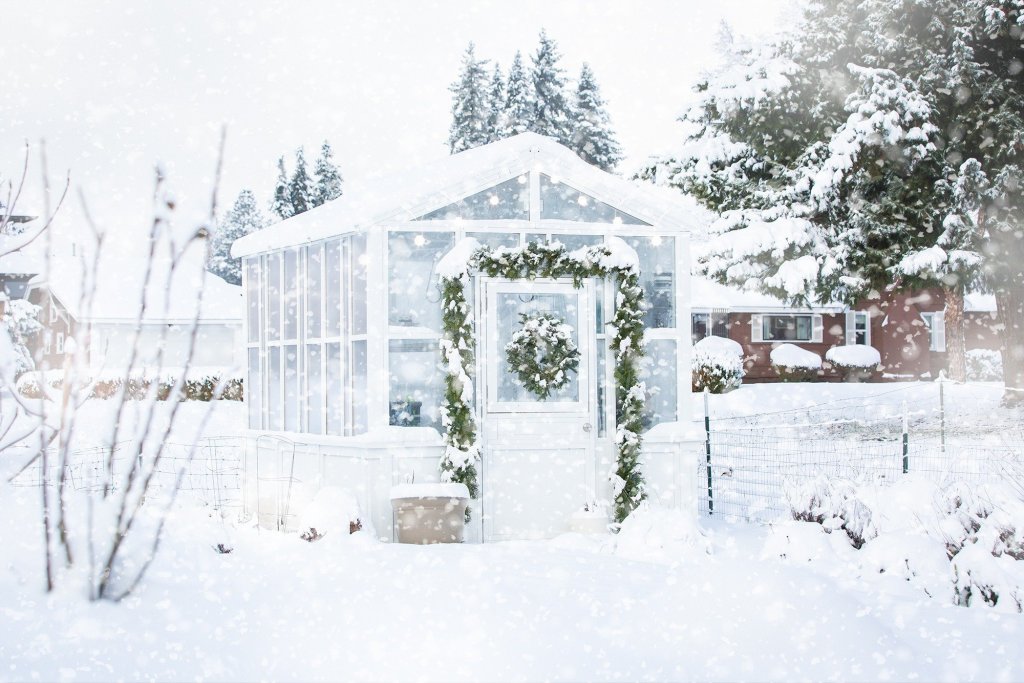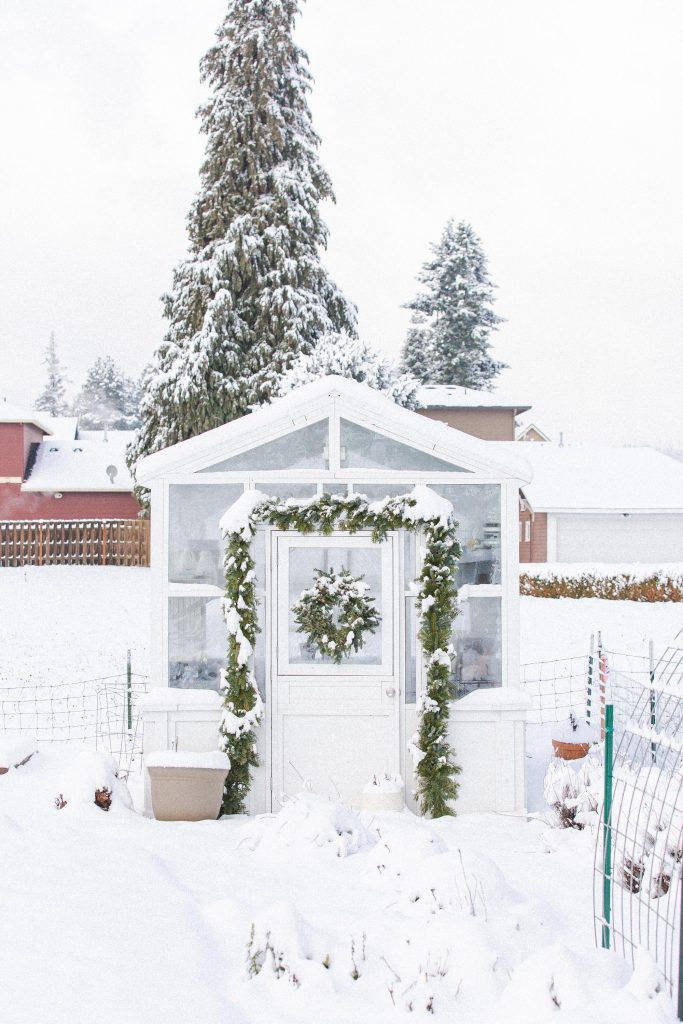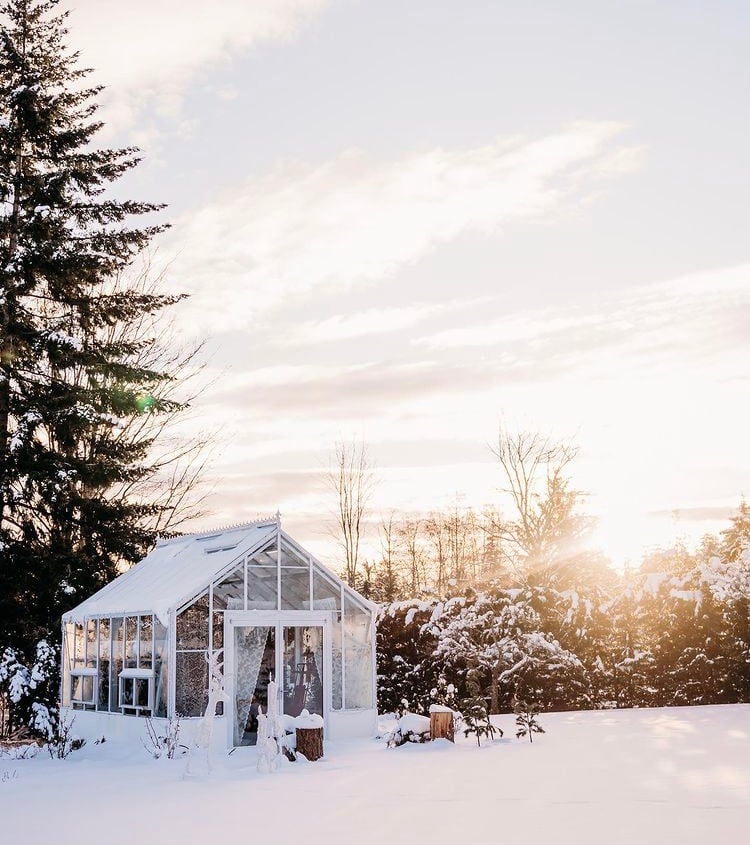
Imagine stepping into a world where vibrant plants thrive, even in the coldest winter months. Picture yourself surrounded by luscious greenery and blossoming flowers, while the snowflakes gently fall outside. This is the magic of a greenhouse in the snow, a haven of life and beauty amidst the frost and chill. In this article, we will discover the enchantment and ingenuity behind these winter wonderlands, and how they bring a touch of springtime to even the darkest of days. So bundle up, put on your cozy winter attire, and prepare to be captivated by the extraordinary allure of a greenhouse in the snow.

This image is property of thefloweringfarmhouse.com.
Choosing the Right Type of Greenhouse
Consider the Climate and Temperature
When choosing a greenhouse for winter gardening, one of the most important factors to consider is the climate and temperature of your area. Different types of greenhouse constructions have varying levels of insulation and temperature control. If you live in an extremely cold climate with harsh winters, you may need a greenhouse with additional insulation and heating capabilities. However, if you reside in a milder region, a less advanced greenhouse may suffice.
Evaluate the Available Space and Budget
Another crucial aspect to consider is the available space and your budget. The size of your greenhouse will depend on the amount of space you have available and the scale of your gardening ambitions. If you have limited space, you may opt for a smaller greenhouse or consider vertical gardening techniques to maximize your growing area. Additionally, it is important to establish a budget to ensure you can afford both the construction and maintenance of the greenhouse.
Select a Suitable Design and Size
Once you have considered the climate, temperature, available space, and budget, you can focus on selecting a design that suits your needs. Popular greenhouse designs for winter gardening include lean-to, freestanding, and attached models. The design you choose should complement your garden and provide ample space for your plants to thrive. Furthermore, the size of the greenhouse should be determined by the number and type of plants you plan to cultivate.
Preparing the Greenhouse Structure
Clearing the Snow and Ice
Before the winter season arrives, it is essential to clear the greenhouse structure of any accumulated snow and ice. These heavy loads can potentially cause damage to the roof, walls, and supporting structures. Using a soft broom or a snow rake, gently remove the snow from the greenhouse, ensuring not to put excessive pressure on the structure. By consistently clearing the snow and ice, you can prevent any potential collapses or structural damages.
Reinforcing the Roof and Walls
To safeguard your greenhouse against the weight of snow and wind, reinforcing the roof and walls is paramount. This can be done by securely fastening additional bracing supports to the frame or installing crossbars for enhanced stability. Reinforcing the greenhouse structure will add an extra layer of protection during inclement weather conditions and ensure the safety of your plants.
Ensuring Proper Ventilation
Even during winter, proper ventilation is crucial for maintaining a healthy growing environment inside the greenhouse. Adequate airflow prevents the buildup of excessive moisture and helps regulate temperature and humidity levels. Ventilation can be achieved by installing vents or exhaust fans that allow for controlled air exchange. It is important to monitor the ventilation system regularly and make adjustments when needed to create an optimal environment for your plants.
Insulating the Greenhouse
Using Double or Triple Glazing
To provide optimal insulation during winter, you can use double or triple glazing on the greenhouse windows. These layered glass panels create an extra barrier against the cold, trapping heat inside and preventing chilly drafts from entering. Additionally, glazing helps to minimize condensation build-up, which can be detrimental to the health of your plants. When choosing glazing options, opt for materials that have high insulation ratings to maximize the effectiveness of the greenhouse’s insulation.
Installing Insulated Panels or Sheets
In addition to glazing, you can further insulate your greenhouse by installing insulated panels or sheets on the walls and roof. These panels are specifically designed to offer superior thermal efficiency, reducing heat loss and preventing cold air infiltration. Insulated panels or sheets are available in a variety of materials, such as polycarbonate and foam core, and can be easily installed to enhance the insulation properties of your greenhouse.
Using Thermal Covers for Plants
To protect your plants from the colder temperatures, consider using thermal covers. These covers act as a barrier against freezing temperatures and provide an additional layer of insulation for your plants. Thermal covers are typically made from materials that can retain heat, such as fleece or bubble wrap. They can be placed over the plants during the coldest nights and removed during the day to allow sunlight exposure. Thermal covers are particularly beneficial for delicate or frost-sensitive plants.
Heating Options for the Greenhouse
Selecting the Appropriate Heating System
Maintaining a stable and suitable temperature inside the greenhouse during winter is crucial for the survival of your plants. Depending on the size of your greenhouse, you have a variety of heating options to choose from. Electric heaters, gas heaters, and even wood-burning stoves are commonly used for greenhouse heating. Consider the energy efficiency, cost-effectiveness, and safety of each heating option before making a decision.
Using Electric or Gas Heaters
Electric heaters are a popular choice due to their ease of use and ability to provide consistent heat. They are available in different sizes and models, allowing you to select the one that best suits your greenhouse’s requirements. Gas heaters, on the other hand, offer powerful heating capabilities and are often more cost-effective in areas with high electricity costs. Whichever heating option you choose, ensure that it is properly installed and that you adhere to all safety guidelines.
Utilizing Renewable Energy Sources
For environmentally-conscious gardeners, utilizing renewable energy sources for greenhouse heating is an excellent option. Solar panels can be installed to harness the sun’s energy and power the heating system of your greenhouse. This not only reduces your carbon footprint but also saves on energy costs in the long run. Additionally, you can explore the use of geothermal heating systems or bioenergy alternatives to further minimize your greenhouse’s impact on the environment.

This image is property of i0.wp.com.
Choosing the Right Plants
Opting for Cold-Hardy Plants
When selecting plants for your winter greenhouse, it is essential to choose varieties that can withstand colder temperatures. Cold-hardy plants are able to tolerate freezing temperatures without being damaged. Examples of cold-hardy plants include kale, spinach, carrots, and cabbage. By opting for these resilient plants, you can continue to enjoy fresh produce throughout the winter months.
Selecting Winter-blooming Varieties
To add a touch of color and beauty to your greenhouse during winter, consider selecting winter-blooming varieties. Flowers such as pansies, winter jasmine, and camellias are known for their ability to bloom during colder months. These winter-blooming plants not only bring cheer and vibrancy to your greenhouse but also attract beneficial insects that aid in pollination, contributing to the overall health of your garden.
Considering Compact or Dwarf Varieties for Limited Space
If you have limited space in your greenhouse, consider planting compact or dwarf varieties of plants. These smaller-sized plants take up less space but still produce a bountiful harvest. Compact tomato plants, dwarf citrus trees, and miniaturized herbs are great options for small-scale winter gardening. By choosing compact or dwarf varieties, you can maximize your greenhouse’s growing capacity without sacrificing variety or yield.
Planting and Caring for Plants
Providing Adequate Watering and Drainage
Proper watering techniques are crucial for the success of your winter greenhouse plants. Although the frequency of watering may be reduced during winter, it is important to ensure that your plants receive adequate moisture. Be mindful of the specific watering requirements of each plant variety and adjust accordingly. Additionally, ensure that the greenhouse has proper drainage to prevent waterlogging and root rot.
Monitoring Humidity and Temperature Levels
Regularly monitoring humidity and temperature levels in your greenhouse is essential for maintaining a healthy growing environment. Invest in a reliable thermometer and hygrometer to accurately measure these parameters. Adjust the temperature and humidity as needed to create an optimal condition for the plants. Adequate airflow and proper ventilation also contribute to maintaining the ideal humidity and temperature levels.
Protecting Plants from Frost and Freezing
During extremely cold nights, it is important to protect your plants from frost and freezing temperatures. Consider using frost cloths or fabric covers to shield delicate plants from the cold. These covers create a barrier that traps heat and prevents severe cold damage. Additionally, keeping planters and pots slightly elevated off the ground can help minimize heat loss and protect root systems from freezing.

This image is property of thefloweringfarmhouse.com.
Implementing a Lighting System
Installing Supplemental Grow Lights
In winter, when daylight hours are shorter, providing supplemental lighting to your greenhouse is essential for the growth and development of your plants. Installing grow lights helps extend the duration of light exposure to mimic longer daylight periods. LED grow lights are energy-efficient and provide the optimal light spectrum for plant growth. Be sure to position the lights at the appropriate distance from the plants to avoid burning or shading.
Using Timers for Optimal Lighting Duration
To ensure that your plants receive consistent and adequate lighting, utilize timers to control the duration of your grow lights. Timers allow you to set specific on and off periods for the lights, providing a regulated cycle for your plants. This also helps automate the lighting process, making it more convenient for you to manage your greenhouse.
Choosing the Right Light Spectrum for Plant Growth
Different plants require specific light spectrums for optimal growth. Understanding the light needs of your plants is important when choosing the appropriate grow lights. Most plants thrive under full-spectrum light, which includes both cool and warm light colors. However, some plants have specific light preferences, such as blue light for leafy growth or red light for flowering. Take the time to research the light requirements of your plants to ensure they receive the right spectrum for their growth stage.
Pest and Disease Management
Implementing Preventive Measures
Preventing pests and diseases is an important part of maintaining a healthy winter greenhouse. Regularly inspect your plants for any signs of infestation or infection. Implement preventive measures such as proper spacing between plants to promote air circulation, regular cleaning and sterilization of gardening tools, and strict hygiene practices. By reducing the potential for pests and diseases to take hold in your greenhouse, you can avoid the need for extensive interventions later on.
Maintaining Proper Plant Hygiene
Maintaining plant hygiene is essential to prevent the spread of diseases and pests. Remove any dead or diseased plant material promptly to prevent them from becoming breeding grounds for pests or pathogens. Regularly clean your greenhouse, including benches, floors, and walls, to minimize the risk of contamination. Additionally, practice crop rotation to prevent the buildup of pests and diseases in the soil.
Using Organic Pest Control Methods
If pests do make their way into your greenhouse, opt for organic pest control methods to minimize any negative impacts on the environment. Introduce beneficial insects, such as ladybugs or predatory mites, to prey on pests naturally. You can also create homemade insecticidal soaps or use organic sprays containing neem oil or garlic extract. These methods are effective in controlling pests while maintaining the overall health of your greenhouse ecosystem.

This image is property of info.bcgreenhouses.com.
Harvesting and Enjoying Winter Produce
Monitoring Growth and Maturity of Crops
As your plants grow throughout winter, it is important to monitor their growth and maturity. Regularly check for signs of readiness, such as color changes or size, to determine the optimal time for harvesting. Different crops have varying harvest times, so stay attuned to individual plant requirements.
Harvesting and Preserving Winter Vegetables
Winter gardening offers a variety of delicious vegetables that can be harvested and enjoyed during the colder months. Leafy greens like kale and spinach, root vegetables like carrots and beets, and cruciferous vegetables like broccoli and cauliflower are excellent choices for winter harvesting. Once harvested, these vegetables can be prepared and stored for consumption throughout the season. Methods such as freezing, canning, or pickling are great ways to preserve the bounty of your winter garden.
Creating Festive Displays with Flowers and Foliage
Winter is not just about vegetables; it can also be a time to showcase beautiful flowers and foliage. Utilize the blooms from your winter-blooming plants to create stunning arrangements and festive displays. Combine flowers with evergreen branches, pine cones, and other natural elements for a truly winter wonderland aesthetic. These displays can be enjoyed both inside your greenhouse and in other areas of your home, adding a touch of cheer and beauty during the colder months.
Maintaining the Greenhouse in Snowy Conditions
Regular Inspection and Snow Removal
Throughout the winter season, regular inspection and snow removal are vital for the safety and functionality of your greenhouse. Keep a careful eye on the structure, checking for any signs of damage or stress. Snow should be gently removed from the roof and sides to prevent excessive weight buildup. Make it a habit to inspect the greenhouse after each snowfall to ensure it remains in optimal condition.
Repairing and Replacing Damaged Parts
If any damage is detected during the regular inspections, it is crucial to address it promptly. Repair or replace any damaged parts to maintain the structural integrity of the greenhouse. Cracked or broken windows, loose panels, or compromised framework should be fixed immediately to prevent further damage and potential collapses. Regular maintenance and timely repairs will ensure the longevity of your greenhouse, allowing you to enjoy winter gardening for years to come.
Applying Anti-Condensation Coatings
Condensation inside the greenhouse can lead to excessive moisture and potential issues such as mold or mildew. To prevent condensation buildup, consider applying anti-condensation coatings to the greenhouse surfaces. These coatings reduce the formation of water droplets and help maintain a drier environment. Additionally, ensure that the greenhouse has proper ventilation to minimize condensation-related problems.
By following these comprehensive guidelines, you can create a successful winter wonderland in your greenhouse. From choosing the right type of greenhouse to harvesting winter produce, each step is crucial in maintaining a thriving gardening space. Embrace the beauty of winter gardening and enjoy the rewards of fresh produce and stunning displays throughout the colder months.

This image is property of growingspaces.com.

